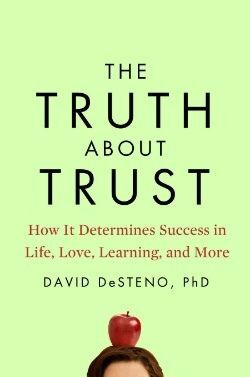
by Maria Popova
The science of why tit-for-tat isn’t the best strategy for cooperation and why you should hear out your hunches.
“When you trust people to help you, they often do,” Amanda Palmer asserted in her beautiful meditation on the art of asking without shame. But what does it really mean to “trust,” and perhaps more importantly, how can we live with the potential heartbreak that lurks in the gap between “often” and “always”? That’s precisely what psychologist David DeSteno, director of Northeastern University’s Social Emotions Lab, explores in The Truth About Trust: How It Determines Success in Life, Love, Learning, and More.
DeSteno, who has previously studied the osmosis of good and evil in all of us and the psychology of compassion and resilience, argues that matters of trust occupy an enormous amount of our mental energies and influence, directly or indirectly, practically every aspect of our everyday lives. But trust is a wholly different animal from the majority of our mental concerns. DeSteno writes:
Unlike many other puzzles we confront, questions of trust don’t just involve attempting to grasp and analyze a perplexing concept. They all share another characteristic: risk. So while it’s true that we turn our attention to many complex problems throughout our lives, finding the answers to most doesn’t usually involve navigating the treacherous landscape of our own and others’ competing desires.
[…]
Trust implies a seeming unknowable — a bet of sorts, if you will. At its base is a delicate problem centered on the balance between two dynamic and often opposing desires — a desire for someone else to meet your needs and his desire to meet his own.
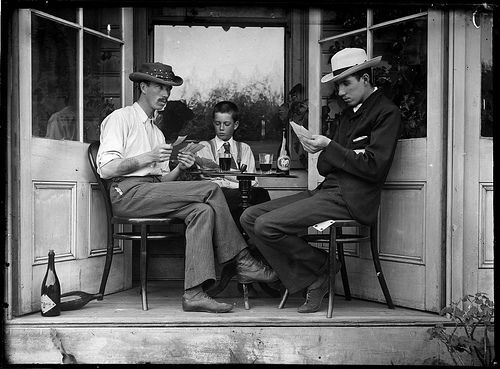
But despite what pop culture may tell us, decades’ worth of attempts to decode the signals of trustworthiness — sought in everything from facial expression to voice to handwriting — have proven virtually useless, and the last five years of research have rendered previous assertions about certain nonverbal cues wrong. (No, a sideways glance doesn’t automatically indicate that the person is lying to you.) As DeSteno wryly observes, “If polygraphs were foolproof, we wouldn’t need juries.” He explains what makes measures of trust especially complicated:
Unlike many forms of communication, issues of trust are often characterized by a competition or battle…. It’s not always an adaptive strategy to be an open book to others, or even to ourselves. Consequently, trying to discern if someone can be trusted is fundamentally different from trying to assess characteristics like mathematical ability. … Deciding to be trustworthy depends on the momentary balance between competing mental forces pushing us in opposite directions, and being able to predict which of those forces is going to prevail in any one instance is a complicated business.
[…]
Contrary to long-held doctrine, isolated gestures and expressions aren’t reliable indicators of what a person feels or intends to do. Two types of context — what I call configural and situational — are essential for correct interpretation. And they’ve been missing in most attempts to discover what trustworthiness and its opposite look like.
To figure out this multifaceted puzzle, DeSteno, whose lab studies how emotional states shape our social and moral behavior, took a cross-disciplinary approach, turning to the work of economists, computer scientists, security officers, physiologists and other psychologists, and enlisting the direct help of social psychologist David Pizarro and economist Robert Frank. With combined expertise spanning behavioral economics, evolutionary biology, nonverbal behavior, and emotional biases in decision making, they built, with equal parts rigor and humility, the richest framework for understanding trust that science has ever accomplished. Specifically, they focused on the two main components of trust — how it works and whether we’re able to predict who deserves it. DeSteno writes:
In the end, what emerged are not only new insights into how to detect the trustworthiness of others, but also an entirely new way to think about how trust influences our lives, our success, and our interactions with those around us. . . .
One of the most profound … is that trust isn’t only a concern that emerges at big moments in our lives. It’s not relevant just to signing a contract, making a large purchase, and exchanging wedding vows. … Whether we realize it or not, issues of trust permeate our days from the time we’re born to the time we die, and it’s often what’s below the surface of consciousness that can have the greatest influence on a life well lived. Our minds didn’t develop in a social vacuum. Humans evolved living in social groups, and that means the minds of our ancestors were sculpted by the challenges posed by living with others on whom they depended. Chief among those challenges was the need to solve dilemmas of trust correctly. And it’s precisely because of this fact that the human mind constantly tries to ascertain the trustworthiness of others while also weighing the need to be trustworthy itself. Your conscious experience may not correspond with this fact, but again that’s because much of the relevant computations are automatic and take place outside of awareness.
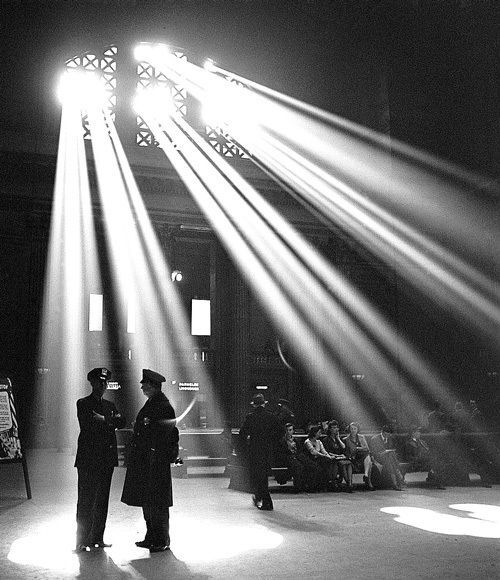
Indeed, trust shapes how we love and how we learn, why we succeed and why we falter, what we buy and what we leave behind. Perhaps most pivotally and uncomfortably, however, trust defines our relationship with ourselves — the quality of the inward gaze and the tangle of dignity, anxiety, uncertainty, and conviction with which we hold it. DeSteno illustrates the backdrop for his exploration:
Although it’s true that cooperation and vulnerability require two parties, no one ever said that the two parties had to be different people. To the contrary, the parties can be the same person at different times. Can the present you trust the future you not to cheat on your diet by bingeing on chocolate cake? Not to cheat on an exam? Not to cheat on your spouse? Not to go gambling again?…
Each of us is never just an observer trying to ascertain whether someone else is to be trusted; we’re also targets of observation ourselves. The same forces that determine whether someone else will be honest or loyal also impinge on our own minds. Assessing the trustworthiness of another and acting trustworthy ourselves, then, are simply two sides of the same coin. Understanding how to predict and control the flip of that coin is what this book is all about.
He begins at the beginning, with a definition of what trust actually is:
At the most basic level, the need to trust implies one fundamental fact: you’re vulnerable. The ability to satisfy your needs or obtain the outcomes you desire is not entirely under your control. . . .
The social lives of humans are characterized by a never-ending struggle between different types of desires — desires favoring selfish versus selfless goals, desires focused on immediate gratification versus long-term benefit, desires stemming from the conscious versus unconscious minds. Only an overriding threat or an amazing confluence of random factors — what we’d otherwise call pure luck — can result in an exact mirroring of two people’s needs and goals at all levels.
Trust, then, is simply a bet, and like all bets, it contains an element of risk.

But risk, as we know, is something we humans are profoundly uncomfortable with — risk is an amplified form of uncertainty which, vital to the creative process as it may be, is remarkably challenging to sit with and let be. Instead, we try desperately to protect our vulnerability by safeguarding against the potential losses implied by risk — so much so that decades of psychology studies have demonstrated that we’re incredibly risk-averse in our decision-making and have a strong bias for loss: we experience far greater distress over losing something than we do delight over gaining the same thing. Why, then, do we ever take risks? DeSteno explains:
The short answer is that we have to. The potential benefits from trusting others considerably outweigh the potential losses on average. The ever-increasing complexity and resources of human society — its technological advancement, interconnected social capital, and burgeoning economic resources — all depend on trust and cooperation. . . . More can be achieved by working together than by working alone. That’s why we trust — plain and simple. The need to increase resources — whether they be financial, physical, or social — often necessitates depending on others to cooperate.
[…]
So, we trust at times; we really don’t have much of a choice. But once we leave the world of verifiability, we inevitably come across more selfish behavior and at the same time face greater difficulty in predicting who will show it. It’s not the case that honesty and loyalty will forever disappear without transparency. As we’ll see, a dynamic equilibrium between trustworthy and untrustworthy behavior will eventually result. Where that equilibrium settles, though, is flexible, and being able to predict it is what much of this book is about.
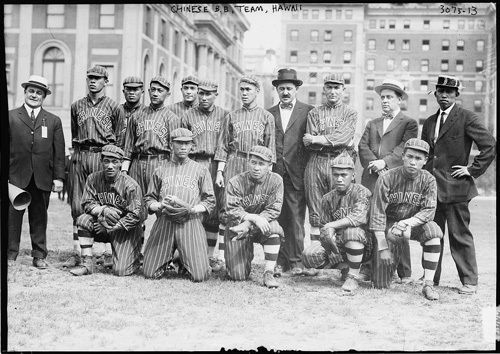
To safeguard ourselves against how this process might go awry, we try to calculate the trustworthiness of others and adjust our own behavior accordingly. The inner workings of those calculations are what psychologists have spent decades studying. When it comes to the trust strategy that works best in life, we tend to rely on the tit-for-tat (TFT) approach in making those assessments and adjustments — in exchanges requiring trust, we start out by being fair, then copy our partner’s actions and responses. But, DeSteno points out, there is one major flaw with this strategy: It doesn’t account for “noise” in the system, meaning those instances where our intentions and our actions disconnect — we breach trust without intending to do so and deceive others by mistake. DeSteno illustrates the problems such noise creates:
Consider the following: two well-intentioned people adopt the TFT strategy for deciding whether to be cooperative with each other. All goes well for a while, but then one of these unintended slights occurs. Person A believes that Person B “defected” on her (whether defection here means intentionally revealing a secret, skimming profits, not working hard enough, etc.), when in actuality Person B’s behavior was accidental (i.e., she didn’t intend to act in an untrustworthy manner). Assuming they both adhere to TFT, the death spiral begins. While tit-for-tat can recover from defections when used against many strategies, this isn’t the case when it’s used against itself. The result is that noise in the system can doom what otherwise appeared to be the superior strategy.
DeSteno points to the work of mathematicians Martin Nowak and Karl Sigmund, who have studied how such noise affects cooperative strategies. To their own surprise, the researchers found in a series of experience that tit-for-tat didn’t emerge as the ideal strategy. Instead, what dominated was a close cousin, which they called “generous tit-for-tat” (GTFT) — an approach somewhat more forgiving than TFT, in which people occasionally chose to cooperate even after their partner had defected. With this extra helping of forgiveness, they were able to overcome that system noise and continue to cooperate smoothly. The most striking finding, however, is that GTFT had a significant flaw — it resulted in a sort of habituation to defection, which over the long run provided fertile ground for exploitation by the dishonest. DeSteno explains the immutable human condition this reveals:
GTFT continued to dominate, the population as a whole became more and more trustworthy. Once everyone is a saint, no one expects to be cheated; everyone cooperates. As a result, the situation becomes ripe for the dishonest. It’s a con man’s paradise; everyone trusts by default. When a random mutation favoring defection again emerges, it’s initially unstoppable. The defectors propagate and gain dominance, pushing more cooperative strategies almost to extinction, only then to decline as the trusting and cooperative reemerge. The insight here is to realize that trust isn’t about finding the perfect single strategy — there isn’t one. It’s about realizing that selfishness and cooperation, disloyalty and trustworthiness, exist in an ever-changing equilibrium. It’s always been that way; it always will.
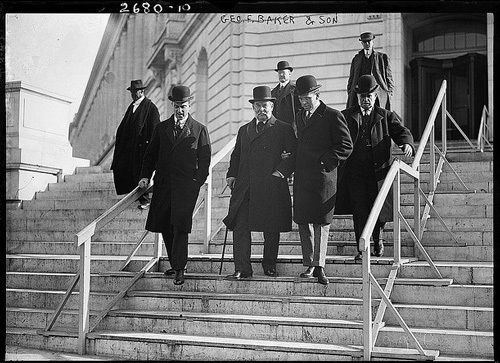
To bypass this conundrum, we often end up navigating problems of trust through reputation, a manifestation of what psychologists term indirect reciprocity, in which we learn and benefit from a peer’s experience. In an ideal world where accurate reputational information is always on hand, the tit-for-tat strategies that begin with fairness-first unconditional trust become less adaptive — if reputation tells us someone we’re meeting for the first time isn’t to be trusted, automatically trusting her unconditionally is a recipe for disaster.
This leads to a beneficial byproduct of reputation: it propagates trustworthy behavior in general, since everyone is suddenly faced with what economists call the shadow of the future — the notion that if you act dishonestly towards someone, word will spread and your negative reputation will precede you in moving forward, significantly damaging your social capital. It’s a risk all the more tangible amidst our age of networked information.
But the most profound findings about trust come from the domain of our greatest vulnerability: love. DeSteno explains what makes this context different from any other arena of trust:
Although it’s true that all types of adult relationships — friendships, business partnerships, team memberships — involve some level of joint dependence for success, their spheres of influence are usually fairly narrow, meaning that individual breaches of trust, though unwelcome, don’t necessarily make one feel universally vulnerable. But this statement comes with one big caveat: love. When it comes to romantic relationships, most adults can have their seeming self-sufficiency momentarily obliterated. It’s not that we become paralyzed or cognitively helpless. We can still reason, research, and analyze. We can still work, cook, and plan for retirement. What we can’t do, though, is turn off that burning desire to connect with a partner — to share, to merge, to depend on, to bare our souls to him or her.
[…]
The losses, real and emotional, that accompany knowing the person you love has decided to leave you — or at least wants to leave you — can make almost any other loss seem trivial by comparison.

And yet, even though a romantic context complicates things, trust still functions in the same basic way — it’s about being sensitive to the future. With a romantic partner, we weigh not only the costs and benefits of the present, but also those ahead. Still, such talk of costs and benefits can feel heartbreakingly sterile and devoid of that ineffable illumination that makes love glow, especially when we consider one of history’s greatest definitions of love, Katharine Hepburn’s timeless words: “Love has nothing to do with what you are expecting to get — only with what you are expecting to give — which is everything.” DeSteno, on the other hand, asserts:
At heart, all romantic relationships are about give and take.
Crudeness aside, there is something to be said for the decades of psychology studies that have indicated what conventional wisdom has advised for centuries — the relationships that flourish are those based on an approximate balance of costs and benefits to both partners. DeSteno himself recognizes how unromantic this model of romance appears and offers valuable perspective:
This description of romantic bliss might sound a bit cold and businesslike, but at the most fundamental level that’s how romantic relationships operate. This dynamic doesn’t preclude the fact that relationships can feel magical at times; our hearts can still flutter from the benefits we receive. Still, whether we enjoy and therefore decide to remain in a relationship depends on just how much we’re willing to do to continue to experience that warm glow. No one can afford to give continuously without receiving, and as a consequence, managing relationships comes down to a balancing act between protecting oneself from exploitation and gaining benefits that can only come from fostering long-term, intimate social bonds.
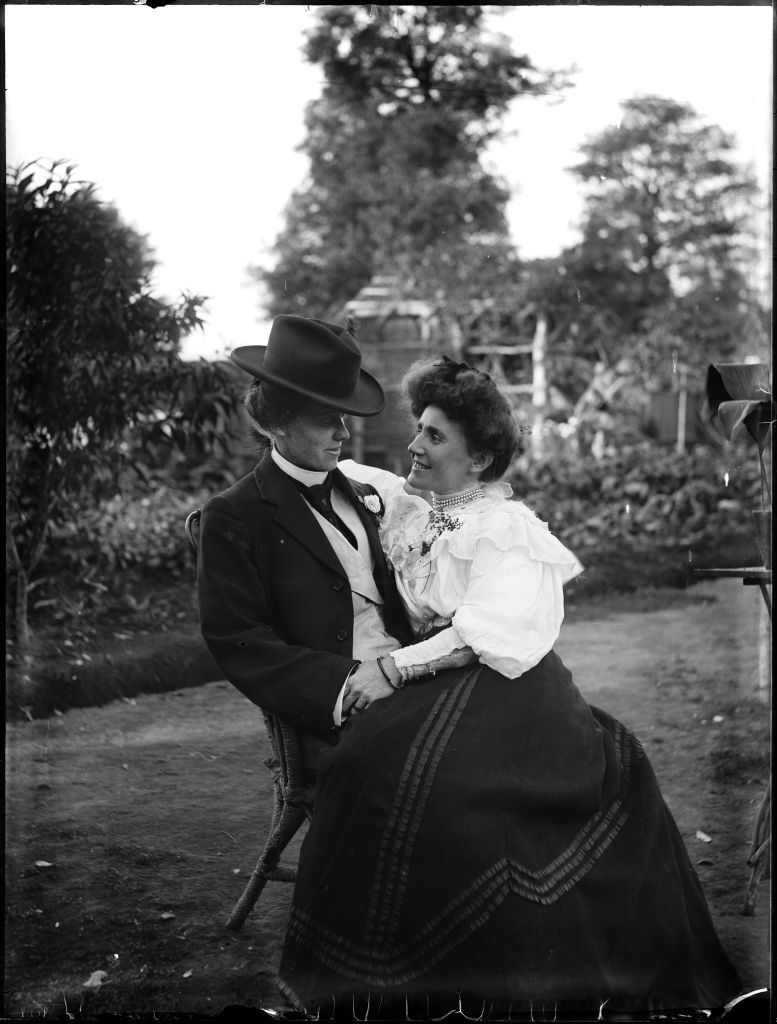
It seems, on the surface, that tit-for-tat is the most intuitive way to keep track of that balancing act — who did what for whom when. But, of course, such a system, is burdensome, frequently flawed, and undeniably disheartening as a concept. It is also riddled with noise, as different partners put different weight on the same actions and decisions. This, DeSteno argues, is where trust comes in: Trust not only alleviates the mind’s cognitive load in making such computations all the time, serving as a sort of shortcut and allowing us to peer into the other person’s mind in matters of reliability. As DeSteno puts it, it’s a well-placed bet that the other partner will hold up his or her end of the relationship bargain:
What ultimately matters for trust to emerge is that individuals are meeting the expectations their partners set, thereby freeing their partners from having to consistently check.
Indeed, the emergence of trust typically marks the ascension to a new level in a relationship, entering a stronger and more stable stage. Yale psychologist Margaret Clark calls this a shift from a exchange-based relationship style to a communal-based one.
To explore the machinery of what drives trust in romantic relationships, DeSteno points to the work of University of Minnesota psychologist Jeffry Simpson, whose lab employs strain-test paradigms — he brings couples in and puts their relationship under various types of stress to observe what happens. For instance, Simpson would ask each partner in a couple to bring up one specific goal that would require a large sacrifice on behalf of the other partner — a work relocation, going back to school, or a change of vocation. Simpson would then observe the dynamics of the couple in discussing the issue, as conflicting interests arise. DeSteno explains the findings:
Jeffry Simpson’s view for how trust works centers on its ability to grease the wheels of romantic relationships — to keep them going strong by biasing not only one’s own behaviors but also one’s interpretations of a partner’s actions. Trust, in essence, functions as a kind of relationship buffer — it smooths rough spots. You can think of it as a kind of love drug. Like many pharmaceutical substances you might take to cope with a stressful event, trust can alter your behavior both by lowering hostility in the moment and by positively biasing your recollections of the past such that potentially problematic events don’t seem to be so troubling after all.
[Simpson's studies] reveal a consistent pattern: individuals who entered discussions with higher levels of trust for their partners demonstrated much greater accommodation and collaboration. Not only were they more willing to listen to their partner’s desires and take them seriously, they also were more motivated to try to find a solution that would be acceptable to both parties. It’s not that trusting individuals were discussing goals that were any less stressful in scope than the ones discussed by their less trusting counterparts; both groups face off over similarly consequential possibilities. The decreased tension and resulting greater success in negotiation derived solely from the subtle effects of trust itself.
At each juncture in the conversation — at each point when a snap decision has to be made about whether to escalate conflict to protect one’s interests — trust intuitively tips the scale back toward de-escalation and compromise. Simply put, trust alters the mental calculus running in the background of our minds. It makes us consider what we have to lose in the long run if we harm this relationship in pursuit of a short-term victory.
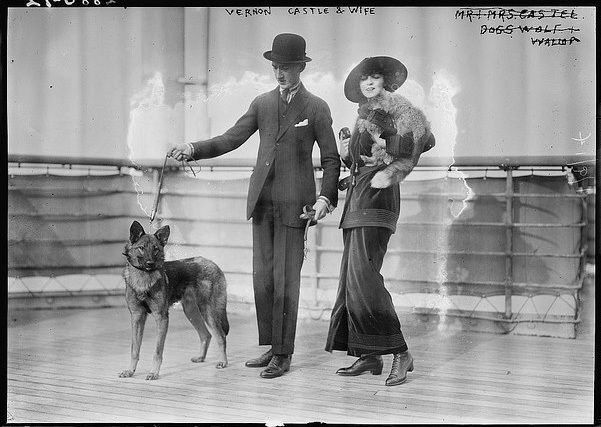
On the flip side, such negotiations around conflicting interests can scar a relationship and taint one partner’s perception of the other as more selfish or difficult than originally thought. But DeSteno points out that even in those cases, trust is the antidote to such toxic impressions — people in thriving relationships, who had entered the negotiation with a high level of trust in their partner, were able to change those impressions after the fact by consistently overestimating how much their partner had accommodated their needs. DeSteno writes:
Put simply, the more trust you have for a partner, the more you view his or her actions as noble sacrifices. Now, you might also guess that it works the other way as well — seeing a partner’s sacrifices as more substantive leads to even greater trust in her or him. And you’d be right. The ultimate effect of the biasing influence of trust is just that — it self-propagates.
This virtuous cycle of trust begetting trust, it turns out, is both what holds relationships together in the first place and what prevents damage under stress.
The most intriguing aspect of the psychology of trust in romantic relationships, however, comes from the frequently conflicting input of reason and intuition, especially in matters of jealousy. As it turns out, the secret to resolving such issues is not in choosing one over the other but in learning to harness the osmosis of these two different modalities and how their parallel processes work in the brain. We already know that our intuition is full of marvels and flaws, which we need to balance in order to be able to trust ourselves. DeSteno writes:
Neither deliberate nor intuitive mental calculations always provide the best answers when it comes to trust. Both aim to solve the problem, but neither is perfect. To make the best choice, you need to understand how both systems work together.
Intuitive trust, or impulsive trust, as it’s sometimes termed, refers to evaluations of a partner’s trustworthiness that occur outside of conscious awareness. . . . Reasoned, or reflective, trust is just the opposite. It’s an assessment based on deliberate analysis. It’s the kind of trust we often call into question when we’re engaging in what-ifs.
[…]
How the mind deals with these questions and concerns — whether they even arise in the first place — holds important consequences for the success of relationships.
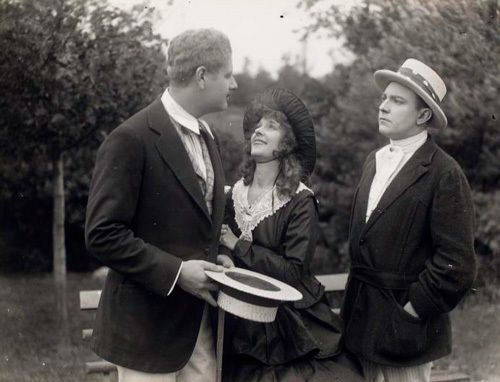
It’s a familiar proposition: If your partner works — or teaches, or paints — late too many nights in a row, you might begin to wonder whether she’s falling out of love with you or, doubly distressing, in love with someone else. In such instances, we resort to reflective trust as we begin weighing our partner’s trustworthiness and all the evidence for or against it. But this seemingly rational strategy, DeSteno cautions, is fraught with flaws, most significantly the assumption that we can consciously control which type of evaluation we’re actually favoring:
As one example, the attributions we make for the causes of past behaviors are often erroneous. Yet even if this analytic process were entirely objective, its results alone would not provide a perfect prediction for what we would ultimately decide to do. Remember, assessments of trustworthiness operate at two levels. Whether a troubling hmmm leads to a true recalibration of trust hinges as much on the analysis going on outside of awareness as on the one the conscious mind is directing.
What psychologists have found, rather, is that intuitive trust takes over when the conscious mind can’t or chooses not to override them. The process is closely aligned with how willpower works, which is like a muscle that can get fatigued when overexerted. Similarly, because the cognitive load of evaluating the costs and benefits of every single daily decision would weigh us down significantly, our intuitive mind alleviates the burden with its effortless, quick-and-dirty shortcuts. This, DeSteno reminds us, is a fruitful feature rather than a bug of the human mind — but therein, perhaps, lies the irony of the trust-your-gut adage, which makes a rational appeal for an intuitive process.
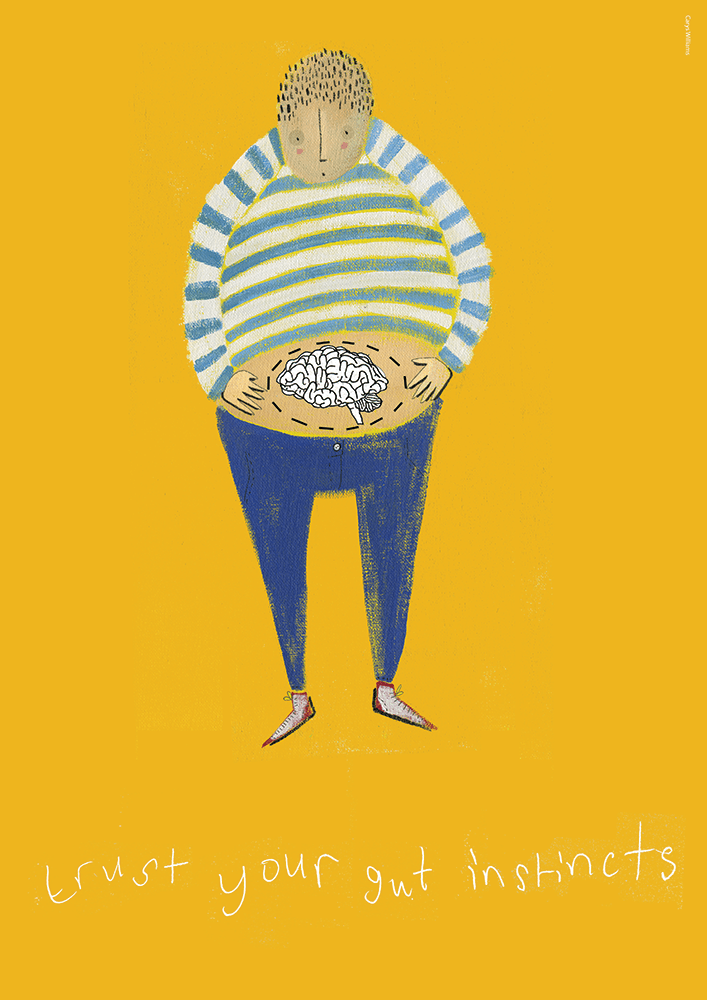
'Trust your gut instincts' by Carys Williams from the 'Advice to Sink in Slowly' project. Click image for details.
Which system we favor, it turns out, is largely decided by our level of executive control — our deftness at commanding reasoned analysis and suppressing intuitive interpretations. DeSteno cites the research of psychologist Sandra Murray, who has spent years studying how couples manage those trust-related negotiations, using both intuitive and rational strategies. This is what she found:
Individuals who possessed high executive control — those who were able to devote mental capacity to a deliberate analysis of their partner’s behaviors — were principally guided by reflective trust in how they dealt with their significant others. After considering all the data at hand, if they believed there wasn’t sufficient reason to doubt their partners, they continued to trust and drew closer to them. If, on the other hand, their analysis raised a red flag and supported their initial concern, they began to distrust their partners and withdrew from them.
For those low in executive control — those who habitually didn’t like to analyze things or were too tired or busy to do so — it was another story completely. Their intuitions tended to shape their responses. For example, if a husband stopped to wonder why his wife was scheduling extra appointments with her attractive athletic trainer, whether this pause led to continued trust or to its withdrawal depended on what the husband’s underlying intuitions were. If on a gut level he possessed a deep and abiding sense of trust in her, he simply disregarded the incident and continued to feel confident in her loyalty. But if his gut harbored suspicions that he couldn’t trust her, even if he wasn’t quite sure why, he readily assumed she was up to no good even though a reasoned analysis wouldn’t have led most individuals to make that assumption. The subsequent impact on relationships was just as you’d expect. Those who intuitively trusted reinforced bonds; those who intuitively distrusted distanced themselves from partners.
What this means is that despite our best efforts otherwise, our hunches about whether or not our partner is to be trusted will sometimes severely skew how we perceive him or her in a given situation. It pays to be aware that even if we have high executive control, it, just like willpower, can and often will be so strained by stress, emotional turmoil, or cognitive overload that we’ll default to intuitive interpretations, which can be warped and colored by irrational factors — it is then that a high level of baseline trust in our partner helps put our minds at ease rather than spin out into disaster scenarios.
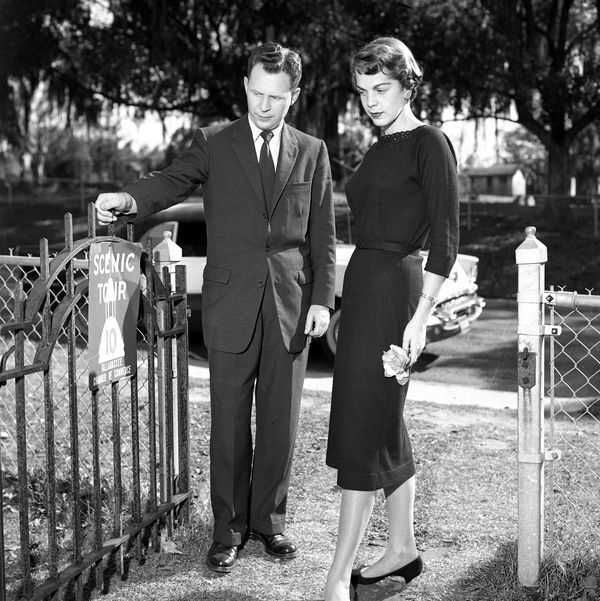
But while trusting, say, a brand might be a matter of buying into a promise or expectation, trusting a romantic partner requires a far greater degree of vulnerability — after all, being disappointed by a new pair of shoes can be infuriating at most, while being betrayed by a partner is nothing short of heartbreaking. It seems most adaptive, then, for the intuitive mind to adopt an automatic approach akin to the generous tit-for-tat strategy — but that’s not necessarily what happens in situations when intuitive distrust poisons a relationship where every rational indicator suggests there is no reason for doubt. DeSteno explains the forces at work:
It’s important to recognize a common misconception about intuitive processes. Although they’re often generally referred to as quick and dirty, when it comes to discerning trustworthiness, the “dirty” part is a bit of a misnomer. As we’ll see in the coming chapter on detecting trustworthiness, intuitive processes likely provide more accurate information than reflective ones. Although neither type of mechanism is perfect, a combination of the two often provides the best results; two heads — or minds, in this case — are always better than one. Yet in absence of having access to both, reliance on intuition for assessing trustworthiness is often a better choice.
The applications of this insight in daily life are especially poignant when it comes to jealousy, a phenomenon at once nearly universally experienced and profoundly misunderstood, as well as nearly impossible to pin down. DeSteno describes it as “a combination of fear, anger, and sadness that gnaws at the soul.” Rather than an emotional plague to be avoided, however, DeSteno argues that jealousy is actually a useful part of the mind’s arsenal because, tabloid fodder aside, jealousy isn’t about sex — it’s about trust. He writes:
At the most fundamental level, jealousy’s purpose is to increase the odds of trustworthy behavior, whether that means preventing the loss of an existing relationship and its associated benefits, or working to ensure that future relationships will be characterized by greater loyalty. Sex is only one benefit; jealousy is sensitive to all benefits.
[…]
If this view of jealousy is correct, it leads to two somewhat counterintuitive predictions. First, if jealousy is about trust, it should, at early stages of threat, push one to be more accommodating to a partner, not less. If you’re worried that a partner may leave you for someone else, being angry at or punishing him will only end the relationship faster. Second, jealousy should be sensitive not only to the real costs and benefits of a relationship, but also to potential ones. In other words, jealousy, like all trust-relevant phenomena, should be sensitive to the shadow of the future.
Indeed, this is precisely what Sandra Murray’s research found: When one partner felt a twinge of jealousy toward the other, she altered her behavior in a way that would foster a greater degree of dependence in the other partner — cook a favorite meal or run an extra errand for her partner. DeSteno explains:
Rather than push the “superior” spouse away into the arms of another by being angry, the inferior-feeling spouse strove to make her- or himself indispensable — a partner on whom the other could rely. And it worked. On days following such dependence-enhancing behaviors, jealousy-inducing partners reported diminished doubts about their commitment to the relationship.
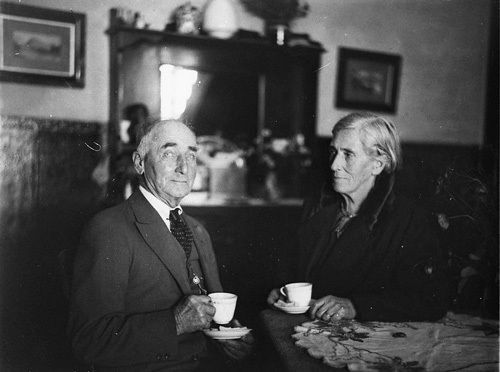
So where does all of this leave us? DeSteno summarizes:
Trust begets trust more often than not. Although common sense may seem to suggest that illusions are always to be avoided in favor of hard objectivity, sometimes a softer-focus lens, one capable of smoothing the rough edges, is to be preferred. If you’ve developed a strong sense of trust in a partner, it will function in just that way. When there’s ambiguity about how trustworthy he or she is, that sense of preexisting trust will burnish your view; it’ll blur the lines in an effort to push you toward continuing to trust. And, in reality, that’s not a bad thing. … Many instances of perceived untrustworthiness are errors or aberrations. Consequently, forgiveness is a great strategy.
As for the age-old tension between reason and intuition, it turns out that Susan Sontag was right in asserting that intuition and the intellect serve us best in tandem. DeSteno writes:
Intuitions, or hunches, are usually less variable than conscious evaluations. As a result, they [tend to] provide more accurate assessments of another’s trustworthiness. There are two reasons for this superiority. The first, as we’ll see in chapter 6, is that the nonconscious mind is more attuned to reading the true indicators of trustworthiness than is the conscious one. The second is that the nonconscious mind is also less amenable to our own influence. We’ve all had the experience of trying to talk ourselves into or out of something, meaning that we’ve all had the experiencing of trying to override our intuitions.
He adds a word of empirically tested advice:
Listen to your hunches; hear them out. While intuitions may not always be right, they are more often than not — a fact alone that warrants their consideration.
But arguably the most tumultuous arena of trust is the question of trusting ourselves, especially when it comes to pursuing future rewards or avoiding future losses. It’s a premise that requires our future self trust our present self with an accurate prediction followed by appropriate behavior, but DeSteno points to two illusions that often derail our predictions and behaviors: forward-looking myopia, or our tendency to focus more on the present than on the future, and rearward-looking whitewash, or our penchant for rationalizing our untrustworthiness and assigning blame elsewhere.
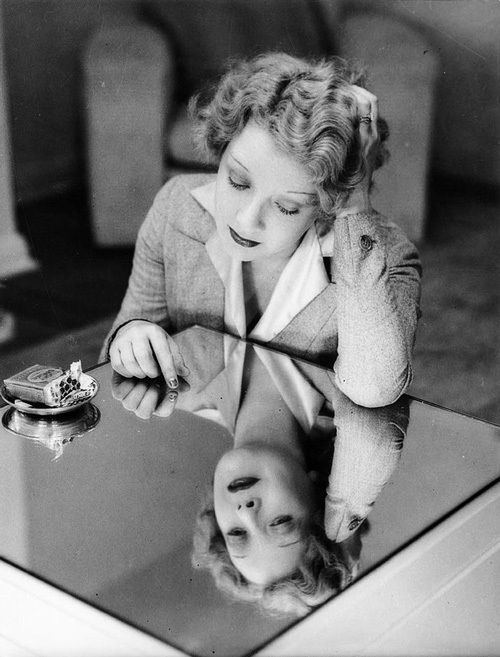
So where does all of this leave us? DeSteno summarizes:
Trust begets trust more often than not. Although common sense may seem to suggest that illusions are always to be avoided in favor of hard objectivity, sometimes a softer-focus lens, one capable of smoothing the rough edges, is to be preferred. If you’ve developed a strong sense of trust in a partner, it will function in just that way. When there’s ambiguity about how trustworthy he or she is, that sense of preexisting trust will burnish your view; it’ll blur the lines in an effort to push you toward continuing to trust. And, in reality, that’s not a bad thing. … Many instances of perceived untrustworthiness are errors or aberrations. Consequently, forgiveness is a great strategy.
As for the age-old tension between reason and intuition, it turns out that Susan Sontag was right in asserting that intuition and the intellect serve us best in tandem. DeSteno writes:
Intuitions, or hunches, are usually less variable than conscious evaluations. As a result, they [tend to] provide more accurate assessments of another’s trustworthiness. There are two reasons for this superiority. The first, as we’ll see in chapter 6, is that the nonconscious mind is more attuned to reading the true indicators of trustworthiness than is the conscious one. The second is that the nonconscious mind is also less amenable to our own influence. We’ve all had the experience of trying to talk ourselves into or out of something, meaning that we’ve all had the experiencing of trying to override our intuitions.
He adds a word of empirically tested advice:
Listen to your hunches; hear them out. While intuitions may not always be right, they are more often than not — a fact alone that warrants their consideration.
But arguably the most tumultuous arena of trust is the question of trusting ourselves, especially when it comes to pursuing future rewards or avoiding future losses. It’s a premise that requires our future self trust our present self with an accurate prediction followed by appropriate behavior, but DeSteno points to two illusions that often derail our predictions and behaviors: forward-looking myopia, or our tendency to focus more on the present than on the future, and rearward-looking whitewash, or our penchant for rationalizing our untrustworthiness and assigning blame elsewhere.
To solve the paradox, DeSteno argues, we need to master time-distortions and allow our present selves to communicate with our future selves directly across time, bypassing rearward-looking whitewash and letting our past selves remind our future selves that we are bound to make mistakes, even after we’ve promised not to make them. This lends a whole other layer of veracity to philosopher Daniel Dennett’s assertion that “the chief trick to making good mistakes is not to hide them — especially not from yourself.”
An excellent and enormously enriching read in its entirety, The Truth About Trust goes on to explore the intricacies of navigating trust with ourselves and others in contexts as wide-ranging as power and money, love and sex, and the dynamics of the social web.
See article from source:
Public domain photographs via Flickr Commons
The Psychology of Trust in Work and Love.
